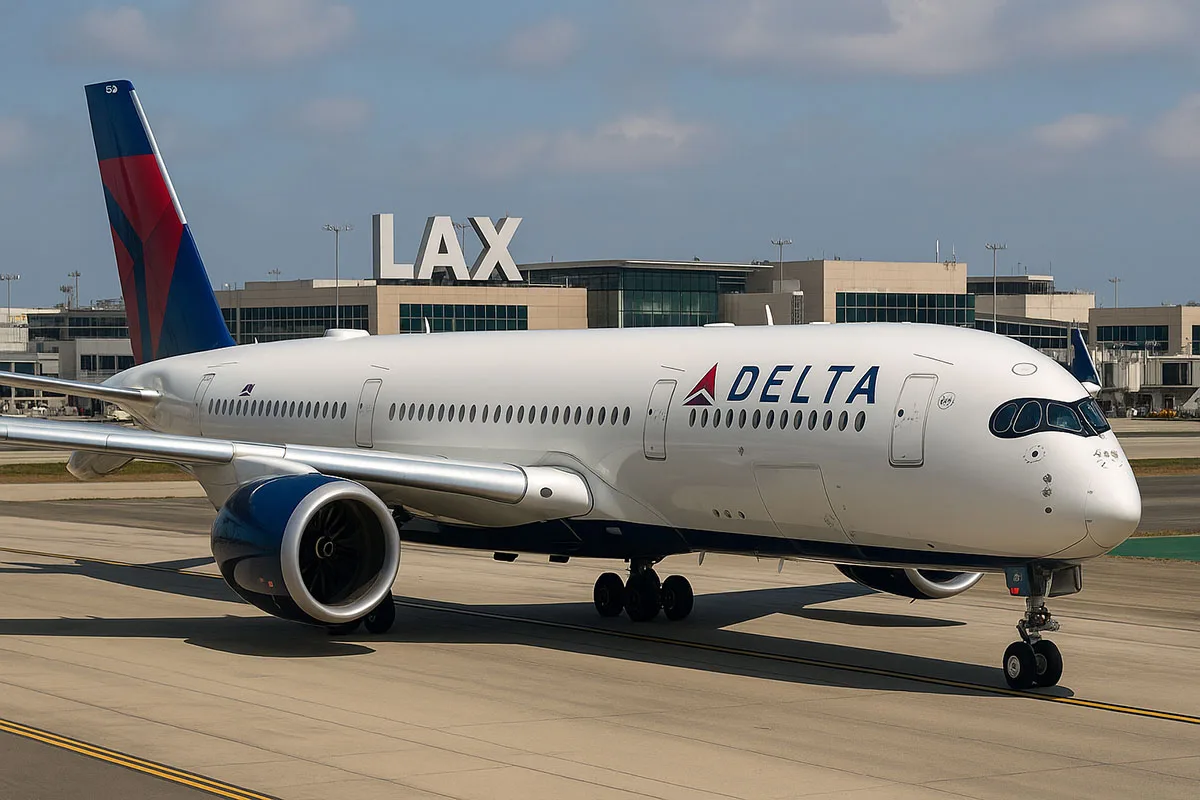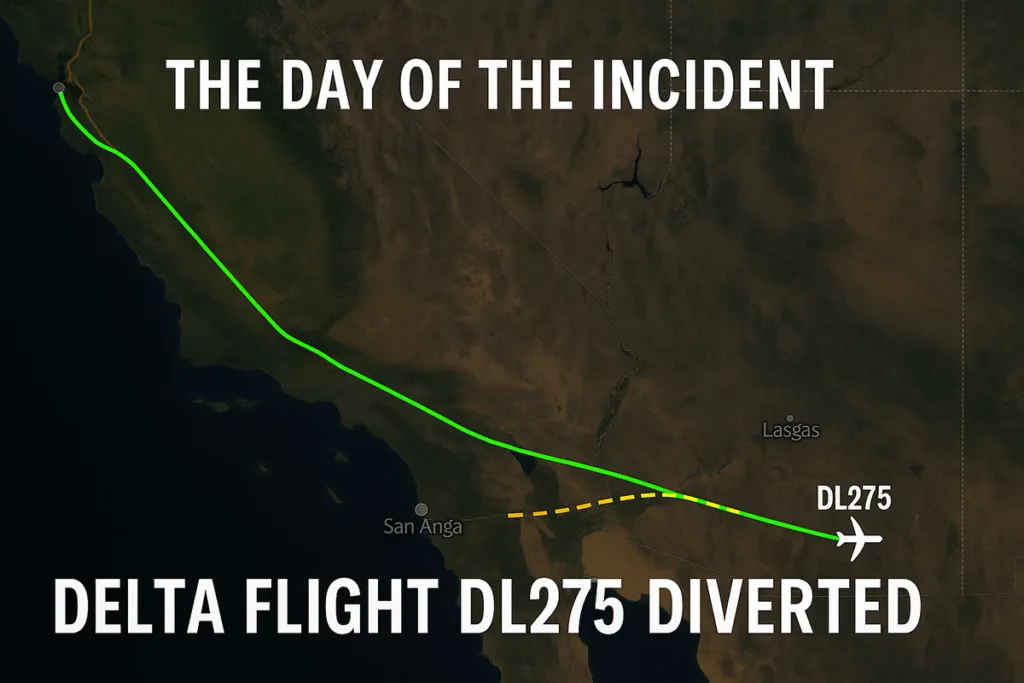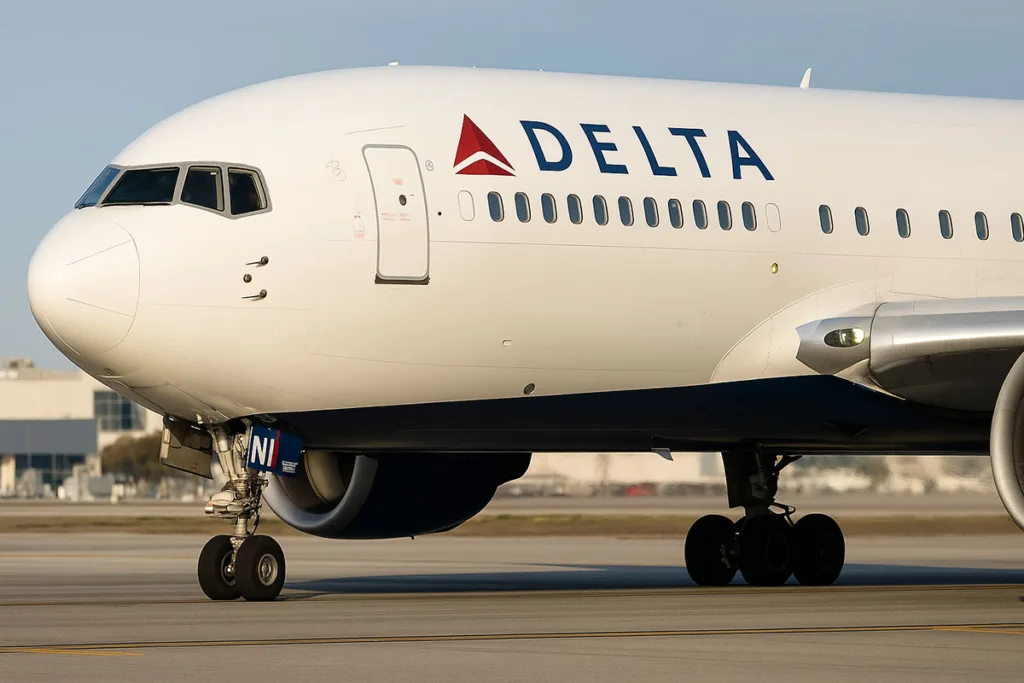Delta Flight DL275 Diverted LAX: What Really Happened!

Delta Flight DL275 was operating trouble-free on May 28, 2025, from Detroit to Tokyo Haneda. Passengers expected a long but uneventful journey across the Pacific. Midway, things changed. The pilot announced the flight would divert to Los Angeles International Airport.
At first, many travelers were confused. Why LAX? Why the abrupt change in plans? What happened in midair? The answer lay in the aircraft’s engine system. An essential component meant to stop ice accumulation stopped functioning. Safety protocols left no room for risk.
The decision to divert was quick and precise. Los Angeles was chosen for its advanced maintenance facilities and Delta’s operational hub. The landing was safe, but the incident raised questions among passengers and aviation enthusiasts alike.
This article explains what happened, why it happened, and what experts say about Delta Flight DL275’s diversion to LAX.
Overview of Delta Flight DL275
Delta Flight DL275 is one of Delta Air Lines’ most important transpacific routes. It connects Detroit Metropolitan Wayne County Airport (DTW) in the United States to Tokyo Haneda Airport (HND) in Japan. This flight serves hundreds of passengers daily, many of them business travelers and frequent flyers.
Aircraft and Configuration
The Airbus A350 is a contemporary, long-range aircraft that DL275 uses for operations. It features:
- Rolls-Royce Trent XWB engines are designed to be dependable and efficient.
- Advanced systems for safety, navigation, and passenger comfort.
- Business class, premium economy, and economy cabins are among the roomy seating options.
Importance of the Route
This route holds significance for several reasons:
- It provides a direct connection between a major U.S. hub and one of Asia’s busiest airports.
- It supports both tourism and business travel, making it vital for Delta’s Pacific network.
- It highlights Delta’s commitment to maintaining high operational standards on international flights.
Operational Background
Flight DL275 usually runs smoothly and is recognized for on-time performance. Its consistent reliability has made it a preferred choice among frequent international travelers.
The Day of the Incident

The events of May 28, 2025 began like any other international flight. Delta Flight DL275 departed Detroit on time, carrying passengers expecting a smooth journey to Tokyo Haneda. Everything proceeded according to plan for the first few hours. Then the situation changed.
Timeline of Events
- Early flight hours: Passengers settled in, meals were served, and the aircraft cruised steadily over U.S. airspace.
- Midway into the flight: The cockpit crew detected a problem with the engine’s anti-ice system.
- Decision point: After running safety checks, the pilots decided it was safer to divert rather than risk flying over the Pacific with a technical fault.
This decision was made quickly, following standard aviation safety protocols.
Pilot and Crew Response
The pilots informed air traffic control first. Then they explained the situation to passengers. Many travelers were surprised, but the calm tone of the announcement helped maintain order. The crew answered questions and reassured passengers about their safety.
Social Media and Real-Time Updates
Some passengers shared the diversion news online. Flight tracking apps showed the aircraft changing course toward Los Angeles, which caught the attention of aviation enthusiasts. Discussions began immediately on platforms like Reddit and Twitter as the flight headed safely toward LAX.
This timeline marked the beginning of what would later become a widely discussed incident.
Technical Cause of Diversion

The decision to divert Delta Flight DL275 to LAX was not random. It was triggered by a specific technical problem detected midair. Understanding this fault helps explain why the pilots made their choice quickly and why safety came first.
The Engine Anti-Ice System Failure
The Airbus A350 uses Rolls-Royce Trent XWB engines. To avoid ice accumulation on turbine blades and sensors, these engines are equipped with an anti-ice system. At high altitudes, freezing temperatures can cause ice to form quickly. Ice affects sensors, decreases airflow, and, if ignored, can harm the engine.
On May 28, this system failed on one engine. While the plane remained stable, flying over the Pacific without anti-ice protection posed serious risks. There are few options for emergency landings over open water. That made diversion the safest choice.
Risks of Continuing Without the System
If the crew ignored the warning, possible risks included:
- Engine power loss from ice affecting airflow.
- Sensor malfunctions leading to inaccurate readings.
- Reduced efficiency and higher fuel burn from ice accumulation.
Such risks grow worse during long transoceanic flights where alternate airports are far apart.
Why Pilots Acted Quickly
Modern aviation protocols leave no room for hesitation when safety is involved. The moment the failure was confirmed, standard operating procedures required the crew to divert to the nearest airport with technical support and long runways.
For this reason, Los Angeles was selected as the destination. It had the right equipment, personnel, and facilities to handle the A350 and diagnose the problem safely.
Why LAX Was the Diversion Airport
The diversion of Delta Flight DL275 to Los Angeles was not just a convenient choice. It was the most practical and safest option. The decision combined technical, operational, and safety factors that aligned with industry best practices.
Advanced Maintenance Facilities
Los Angeles International Airport (LAX) is a major place for operations and maintenance of Delta. It is equipped with:
- Specialized maintenance hangars for Airbus A350 aircraft.
- Certified technicians for Rolls-Royce Trent XWB engines.
- Immediate access to diagnostic tools and parts.
This infrastructure allowed Delta to inspect and address the anti-ice issue without delays.
Operational Benefits of LAX
LAX offered advantages that no other West Coast airport could match:
- Long runways suitable for a heavy, long-haul A350.
- Experienced ground teams trained to handle complex international diversions.
- Support services for passengers, including quick rebooking and customer assistance.
These factors made LAX the safest and most efficient destination for an unplanned landing.
Strategic Location
Another reason for choosing Los Angeles was geography. The route to LAX provided a direct and stable path from the aircraft’s position when the fault was detected. A warmer climate also minimized further icing risks, adding another layer of safety during descent and landing.
In the end, this decision showed how preparation and planning can turn a critical in-flight situation into a controlled and safe outcome.
Passenger Experience Onboard
The diversion of Delta Flight DL275 was a surprise for passengers. Many expected a long but routine flight to Tokyo. Instead, midair announcements brought unexpected news.
Initial Reactions from Passengers
The passengers’ responses varied when the pilot told them about the diversion:
- Some were anxious, concerned about possible risks.
- Others stayed calm, trusting the crew’s judgment.
- A few passengers began sharing updates on social media.
The lack of turbulence or visible issues helped keep panic levels low. Most travelers simply wanted clear information.
Role of the Flight Crew
The cabin crew handled the situation professionally. They:
- Answered passenger questions calmly.
- Provided regular updates about the flight’s status.
- Ensured everyone remained comfortable until landing.
Clear communication helped reduce confusion and kept the cabin environment orderly.
Social Media Updates and Public Interest
Some travelers live-posted the diversion on platforms like Twitter and Reddit. Flight tracking apps displayed the sudden change in route, attracting attention from aviation enthusiasts. Comments ranged from curiosity about the technical issue to praise for Delta’s quick response.
Atmosphere Before Landing
Anxiety gave way to relief as the plane got closer to Los Angeles. Passengers understood safety was the priority. The smooth landing ended hours of uncertainty, leaving many grateful for the crew’s professionalism and the airline’s handling of the situation.
This experience showed how effective communication can keep passengers calm during unexpected events.
Behind the Scenes at LAX
When Delta Flight DL275 touched down at Los Angeles International Airport, the work behind the scenes moved fast. The focus was safety, technical checks, and passenger support.
Immediate Ground Operations
Ground crews guided the Airbus A350 to a secure gate. Within minutes:
- Technicians connected diagnostic equipment to the aircraft.
- Engineers communicated with the cockpit crew to review in-flight data.
- Support staff coordinated with Delta operations to prepare passenger assistance.
The goal was to inspect the aircraft without delay and keep everyone informed.
Maintenance and Safety Checks
Expert teams investigated the engine’s anti-ice system and other parts. Their priority was to confirm the source of the issue and determine if repairs could be completed at LAX. The process involved running system tests and preparing for possible engine component replacements.
Passenger Support and Assistance
Delta’s customer service staff handled passenger needs efficiently:
- Rebooking travelers on the next available flights to Tokyo.
- Offering meal vouchers and hotel accommodations for those facing long delays.
- Giving travelers precise directions and frequent updates to keep them informed.
Smooth Coordination
Airport employees, engineers, and pilots worked together to reduce misunderstandings. This level of teamwork showed how a well-prepared hub like LAX can handle unexpected international diversions with professionalism and care.
By evening, the situation was under control. The aircraft remained grounded for further inspection, while most passengers were safely accommodated and waiting for onward travel plans.
Aviation Experts’ Analysis

The diversion of Delta Flight DL275 was promptly examined by aviation safety specialists. Their comments provided insight into how such decisions are made and why they matter.
Safety Comes First
Analysts emphasized that the diversion was the right call. According to industry experts, an anti-ice system failure is a serious safety concern during high-altitude, long-haul flights. Flying across the Pacific without that protection would have been risky. The decision to divert showed Delta’s commitment to strict safety protocols.
Industry Insights
Specialists in aircraft operations noted three important points:
- Modern aircraft systems can detect problems early, allowing for proactive action.
- Diversions like this are rare but well-rehearsed in training for pilots and crew.
- Major hubs like LAX are prepared to handle technical issues quickly and efficiently.
Comparisons to Similar Cases
Aviation historians compared this incident to previous diversions caused by sensor or system failures. In every case, quick decisions by the crew prevented potential emergencies. DL275 is now another example of procedures working exactly as intended.
Lessons for the Industry
Experts believe the event highlights the importance of continuous monitoring and maintenance of high-tech systems like those on the Airbus A350. They also stress how well-trained crews and clear communication keep passengers safe and calm.
This analysis reinforces one point: aviation safety depends on preparation, teamwork, and decisive action when problems arise.
Lessons Learned from the Incident
The diversion of Delta Flight DL275 offered important lessons for airlines, passengers, and the aviation industry as a whole. It showed how preparation and quick decision-making protect lives when technical problems arise midair.
Key Takeaways for Airlines
Aviation experts highlighted several lessons:
- Early detection systems are essential for spotting possible dangers before they become more serious.
- Pilot training programs must continue to include real-world scenarios for quick and safe diversions.
- Engine anti-ice equipment and other system maintenance schedules should continue to be of utmost importance.
These practices ensure passenger safety stays ahead of operational convenience.
Passenger Perspective
The incident made passengers realize how important it is to trust the crew’s knowledge. Diversions can be inconvenient, but safety decisions are based on strict international standards, not guesswork. Clear communication from airlines helps travelers understand what is happening and why.
Industry-Wide Learning
The event also provided valuable insights for regulators and manufacturers. It reinforced the need for continuous improvements in aircraft systems and emergency response coordination at major airports.
Overall, this incident showed how preparation, technology, and training work together to prevent risks in modern aviation.
Final Thoughts
Everyone was reminded that safety in aviation is always the top priority when Delta Flight DL275 was diverted to LAX. When there was a technical problem, the crew took immediate action and prioritized the safety of the passengers.
This incident also showed the strength of modern systems and training. The aircraft detected the fault early, and the crew’s quick response prevented a situation that could have become dangerous. For travelers, it was a lesson in trusting the professionals in the cockpit and the teams working behind the scenes.
Events like this are rare, but they highlight how advanced today’s aviation operations have become. Every part of the response, from the decision to divert to the smooth landing at LAX, reflected preparation and teamwork.
The story of Delta Flight DL275 Diverted LAX is a clear example of how technology, skill, and communication keep passengers safe every day.
FAQ Section
1. What caused the diversion of Delta Flight DL275 to LAX?
The engine’s anti-ice system failed in midair, forcing the flight to be rerouted. LAX was chosen as it had the technical support, equipment, and certified staff to handle the Airbus A350 safely.
2. Was the diversion dangerous for passengers?
No. The aircraft was stable throughout the flight. The diversion was a precautionary safety measure to prevent risks while flying over the Pacific Ocean.
3. How did Delta assist passengers after landing?
Delta quickly rebooked passengers on the next available flights to Tokyo. The airline also offered meal vouchers, hotel stays for delays, and real-time updates to keep travelers informed.
4. How often do such diversions happen?
Diversions are rare, but they do occur when safety systems detect a problem. Airlines follow strict protocols to handle these situations quickly and safely.
5. What type of aircraft was used for Delta Flight DL275?
The Rolls-Royce Trent XWB engines power the Airbus A350, which is used by Delta Flight DL275. It is a long-range aircraft designed for international routes like Detroit to Tokyo.
For more insightful articles, please visit Bloghart.
